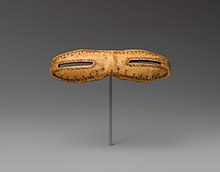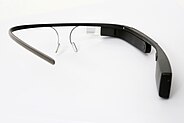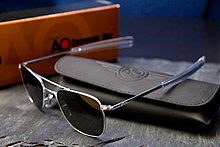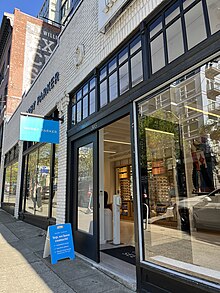
Bausch & Lomb is an American-Canadian eye health products company based in Vaughan, Ontario, Canada. It is one of the world's largest suppliers of contact lenses, lens care products, pharmaceuticals, intraocular lenses, and other eye surgery products. The company was founded in Rochester, New York, in 1853 by optician John Bausch and cabinet maker turned financial backer Henry Lomb. Until its sale in 2013, Bausch + Lomb was one of the oldest continually operating companies in the United States.
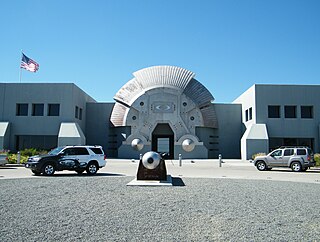
Oakley, Inc. is an American company headquartered in Foothill Ranch, California, which is an autonomous subsidiary of EssilorLuxottica. The company designs, develops and manufactures sports performance equipment and lifestyle pieces including sunglasses, safety glasses, eyeglasses, sports visors, ski/snowboard goggles, watches, apparel, backpacks, shoes, optical frames, and other accessories. Most items are designed in house at their head office, but some countries hold exclusive designs relevant to their market. Oakley currently holds more than 600 patents for eyewear, materials, and performance gear.
Luxottica Group S.p.A. is an Italian eyewear conglomerate based in Milan. As a vertically integrated company, Luxottica designs, manufactures, distributes, and retails its eyewear brands all through its own subsidiaries. The company, presently organized as a subsidiary of EssilorLuxottica which formed when the Italian conglomerate merged with the French optical firm Essilor, is the world's largest company in its industry, both prior to and after its merger with Essilor.

Ray-Ban is a brand of luxury sunglasses and eyeglasses created in 1936 by Bausch & Lomb. The brand is best known for its Wayfarer and Aviator lines of sunglasses. In 1999, Bausch & Lomb sold the brand to Italian eyewear conglomerate Luxottica Group for a reported $640 million.

LensCrafters is an international retailer of prescription eyewear and prescription sunglasses. Its stores usually host independent optometrists on-site or in an adjacent store. The company has its corporate headquarters in Mason, Ohio, a suburb of Cincinnati in the US.
Leonardo Del Vecchio was an Italian billionaire businessman, the founder and chairman of Luxottica, the world's largest producer and retailer of glasses and frames, with 77,734 employees and over 8,000 stores. At the time of his death, his net worth was estimated at US$24.1 billion, the second richest person in Italy, and 54th in the world.

John Jacob Bausch was a German-American maker of optical instruments who co-founded Bausch & Lomb. Over six decades he transformed his small, local optical shop into a large-scale international enterprise, pioneering the American optical industry.

Essilor International is an international ophthalmic optics company that designs, manufactures and markets lenses to correct or protect eyesight. Its headquarters is in Charenton-le-Pont, France.

Aviator sunglasses are a style of sunglasses that was developed by a group of American firms. The original Bausch & Lomb design is now commercially marketed as Ray-Ban Aviators, although other manufacturers also produce aviator-style sunglasses.

Ray-Ban Wayfarer sunglasses and eyeglasses have been manufactured by Ray-Ban since 1952. Made popular in the 1950s and 1960s by music and film icons such as Buddy Holly, Roy Orbison and James Dean, Wayfarers almost became discontinued in the 1970s, before a major resurgence was created in the 1980s through massive product placements.
Foster Grant, or FosterGrant, is an American brand of eyewear founded by Sam Foster in 1919. The Foster Grant brand is a subsidiary company of FGX International, a consumer goods wholesaler with headquarters in Smithfield, Rhode Island, which has been owned by Essilor, today EssilorLuxottica, since 2010.

Browline glasses are a style of eyeglass frames where the "bold" upper part holding the lenses resembles eyebrows framing the eyes. They were very popular during the 1950s and 1960s, especially in the United States of America. The glasses were first manufactured by Shuron Ltd in 1947 under the "Ronsir" brand, and quickly emulated by various other manufacturers. The design became the most common style of eyeglasses throughout the 1950s and the early 1960s before it was surpassed in popularity by solid plastic styles. Browlines enjoyed a renaissance as sunglasses in the 1980s before returning to popularity in the 2010s, with the rise of retro style and the hipster subculture.

Maui Jim is an American sunglasses manufacturer based in Peoria, Illinois.

Safilo Group S.p.A. is an Italian company that designs, produces, and distributes prescription frames, sunglasses, sports eyewear, ski goggles and helmets, and cycling helmets under its own five house brands and 32 licensed brands, including Smith Optics since 1996.
Warby Parker Inc. is an American retailer of prescription glasses, contact lenses, and sunglasses, based in New York City. Founded in 2010, it was initially an online only retailer. It now sells primarily through more than 200 physical retail store locations across the U.S. and Canada.
Eyebuydirect, Inc. is an online retailer of prescription glasses, based in Austin, Texas. The company also sells prescription and non-prescription sunglasses, sport sunglasses, and computer glasses designed to reduce glare. Eyebuydirect was founded in 2005 by Roy Hessel, who was succeeded by Sunny Jiang, chief executive officer since 2017. The company has operations in the United States and China, and sells its products worldwide.

Clearly is an online retailer of contact lenses, eyeglasses and sunglasses. The company was acquired by EssilorLuxottica Canada, and is headquartered in Vancouver, British Columbia. They are one of the largest online contact lens retailers in North America, and the largest seller of prescription eyeglasses online in the world.

Gentle Monster is a South Korean sunglasses and optical glasses brand founded by Hankook Kim in Seoul in 2011.

Costa Del Mar or simply Costa is an American manufacturer of polarized sunglasses based in Daytona Beach, Florida. It is a wholly owned subsidiary of EssilorLuxottica. Their sunglasses are popular in the sport sunglasses market, and are considered good for outdoor sports practicing, such as Summer activities, recreational fishing and boating. Costa's Baffin Sunglasses won Best of Show: Eyewear at ICAST 2018.
EssilorLuxottica SA is an Italian-French vertically integrated multinational corporation based in Paris and founded on 1 October 2018 from the merger of the Italian Luxottica with the French Essilor. The eyewear-focused group designs, produces and markets ophthalmic lenses, optical equipment, prescription glasses and sunglasses.

